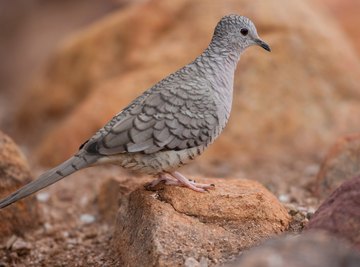
Doves are small, stocky birds belonging to the pigeon family and are known for their low, soft cooing. Some, like the mourning dove are native to the United States, whereas others, such as the white-winged dove, were introduced by human settlers. Each species of dove has its own unique characteristics, but collectively they share several traits in regard to appearance, mating and feeding behavior.
Physical Appearance
Whether a common ground dove or an exotic Inca, all doves have relatively small heads in comparison to their bodies and small, narrow bills. They have short legs and walk as if their feet are tender which causes their heads to bob back and forth. These birds have fairly long tails with distinct color patterns that are useful in identifying the various species. A half dozen species of doves are common to North America; there are 35 recognized colors of the Ringneck Dove alone. Most common colors are shades of gray, white, brown and peach. Doves are known for their powerful, precise flight patterns and the whirling sound created by their wings; mourning doves can reach speeds up to 55 miles per hour.
Feeding and Habitat
Birds need water to survive and doves have the uncanny ability to drink water without raising their head. They feed primarily on grass and grain seeds, with the common ground dove taking in over 2,500 seeds per day to meet its high caloric demands. Doves forage for seed by walking and pecking at the ground, but most won’t move leaves or litter to find seeds. Some species also eat fruits, and white-winged doves even eat snails for calcium and small pebbles to grind plant material in their gizzards. Doves live in open woodlands, urban areas and some species take up residence in dense forests. They are regularly seen perched on power lines and in tree branches.
Raising a Family
Male and female doves work together to build loosely-made nests, usually in the spring, out of grass stems, twigs, moss and pine needles. Nests range in size from three eight inches across and are built on horizontal branches, man-made structures such as gutters or on the ground. Doves can produce multiple clutches in one breeding season, and will reuse nests to raise the young. They also use nests abandoned by other bird species. Mothers and fathers take turns incubating the eggs, a process that takes two to three weeks. When the young are born, their parents feed them crop milk, a secretion that both males and females form in their esophagus.
Migration
Some dove species migrate south during cold winter months. Mourning doves, residents of all of the United States except for Hawaii, migrate to southern states and even as far south as Mexico. The common ground dove only migrates a short distance southward, if at all, whereas the white-winged dove either stays put or migrates south, east or toward the west.
References
- Cornell University: Mourning Dove
- Cornell University: Inca Dove
- Cornell University: Common Ground-Dove
- Cornell University: White-Winged Dove
- North Carolina Wildlife Resource Commission: Mourning Dove
- Audubon: Dynamic Dove Expansions Citizen Science Illustrates the Spectacular Range Expansions Taking Place Throughout North America
- Texas A&M Extension: Mourning Dove
- American Dove Association
About the Author
Diana K. Williams is a certified Master Gardener, has more than a decade of experience as an environmental scientist, and holds a Bachelor of Science degree in biology and environmental studies from the Ohio Northern University. Williams is a winner of Writer’s Digest Magazine's annual writing competition.
Photo Credits
Michael Stubblefield/iStock/Getty Images
